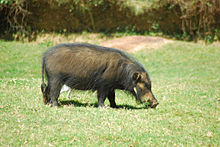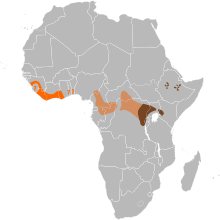Giant forest hog
| Giant forest hog | |
|---|---|

| |

| |
| Scientific classification | |
| Domain: | Eukaryota |
| Kingdom: | Animalia |
| Phylum: | Chordata |
| Class: | Mammalia |
| Order: | Artiodactyla |
| Family: | Suidae |
| Genus: | Hylochoerus Thomas, 1904 |
| Species: | H. meinertzhageni
|
| Binomial name | |
| Hylochoerus meinertzhageni Thomas, 1904
| |

| |
H. m. ivoriensis H. m. rimator H. m. meinertzhageni | |
The giant forest hog (Hylochoerus meinertzhageni), the
Description
The giant forest hog is, on average, the largest living species of suid. Adults can measure from 1.3 to 2.1 m (4 ft 3 in to 6 ft 11 in) in head-and-body length, with an additional tail length of 25 to 45 cm (9.8 to 17.7 in). Adults stand 0.75 to 1.1 m (2 ft 6 in to 3 ft 7 in) in height at the shoulder, and can weigh from 100 to 275 kg (220 to 606 lb).
Distribution

Giant forest hogs occur in west and central Africa, where they are largely restricted to the
Habits
The giant forest hog is mainly a
As all suids of Sub-Saharan Africa, the giant forest hog has not been domesticated, but it is easily tamed and has been considered to have potential for domestication.[4] In the wild, though, the giant forest hog is more feared than the red river hog and the bushpig (the two members of the genus Potamochoerus), as males sometimes attack without warning, possibly to protect their group.[4] It has also been known to drive spotted hyenas away from carcasses, and fights among males resulting in the death of one of the participants are not uncommon.[8] Despite its size and potential for aggressive behaviour, they have been known to fall prey to leopards (probably almost exclusively large male forest leopards which are often larger than their savannah-dwelling equivalents) and clans of spotted hyenas. Although in some localities the lion may also be a predator of giant forest hogs, the species are usually segregated by habitat, as African lions do not generally occur in the densely forested habitats inhabited by this suid.[12][13]
References
- ^ d'Huart, J.; Reyna, R. (2016) [errata version of 2016 assessment]. "Hylochoerus meinertzhageni". IUCN Red List of Threatened Species. 2016: e.T41769A100471546. Retrieved 28 February 2021.
- ISBN 978-84-96553-77-4
- ISBN 1-59797-041-7
- ^ ISBN 0-8018-5789-9
- ^ ISBN 0-12-408355-2
- ^ West, G., Heard, D., & Caulkett, N. (Eds.). (2008). Zoo animal and wildlife immobilization and anesthesia. John Wiley & Sons.
- ^ Estes, R. (1991). The behavior guide to African mammals (Vol. 64). Berkeley: University of California Press.
- ^ a b c d e Huffman, B. (2004). Giant forest hog. Ultimate Ungulates.
- ^ Estes, R. D. (1999). The Safari Companion: A Guide to Watching African Mammals Including Hoofed Mammals, Carnivores, and Primates. Chelsea Green Publishing.
- ^ Dzanga Forest Elephants (2008). Departures and Arrivals.
- .
- .
- .

